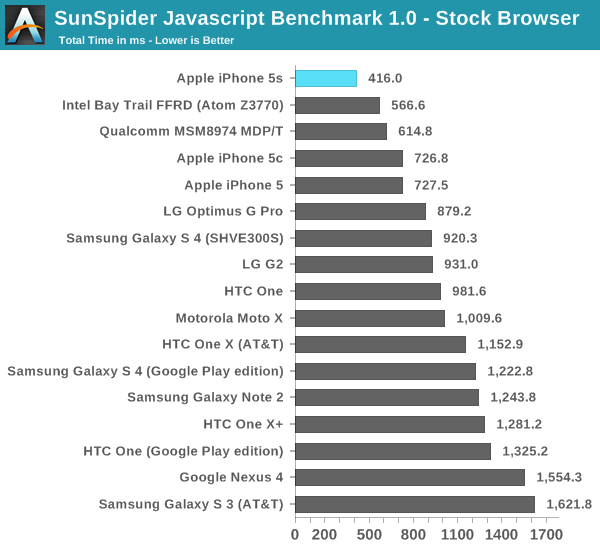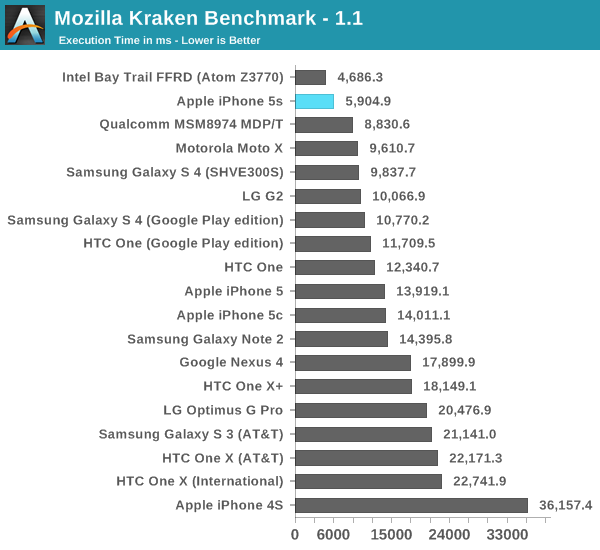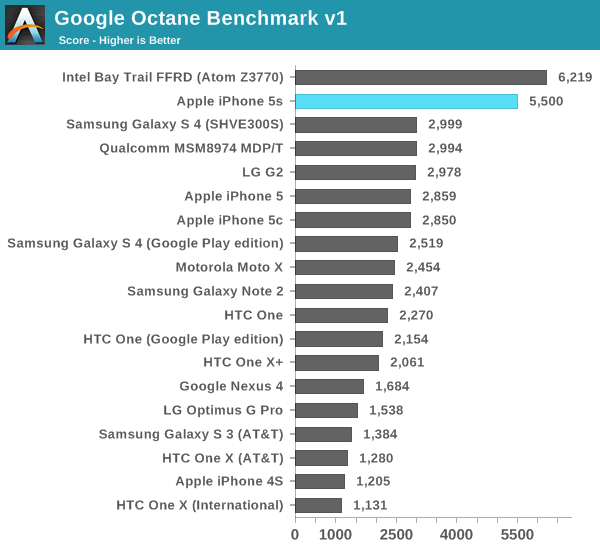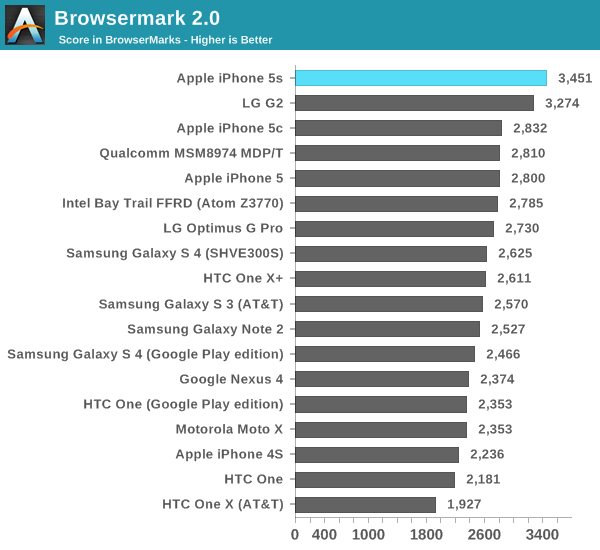The iPhone 5s Review
by Anand Lal Shimpi on September 17, 2013 9:01 PM EST- Posted in
- Smartphones
- Apple
- Mobile
- iPhone
- iPhone 5S
CPU Performance
For our cross-platform CPU performance tests we turn to the usual collection of Javascript and HTML5 based browser tests. Most of our comparison targets here are smartphones with two exceptions: Intel's Bay Trail FFRD and Qualcomm's MSM8974 Snapdragon 800 MDP/T. Both of those platforms are test tablets, leveraging higher TDP silicon in a tablet form factor. The gap between the TDP of Apple's A7 and those two SoCs isn't huge, but there is a gap. I only include those platforms as a reference point. As you're about to see, the work that Apple has put into the A7 makes the iPhone 5s performance competitive with both. In many cases the A7 delivers better performance than one or both of them. A truly competitive A7 here also gives an early indication of the baseline to expect from the next-generation iPad.
We start with SunSpider's latest iteration, measuring the performance of the browser's js engine as well as the underlying hardware. It's possible to get good performance gains by exploiting advantages in both hardware and software here. As of late SunSpider has turned into a bit of a serious optimization target for all browser and hardware vendors, but it can be a good measure of an improving memory subsystem assuming the software doesn't get in the way of the hardware.

Bay Trail's performance crown lasted all of a week, and even less than that if you count when we actually ran this benchmark. The dual-core A7 is now the fastest SoC we've tested under SunSpider, even outpacing Qualcomm's Snapdragon 800 and ARM's Cortex A15. Apple doesn't quite hit the 2x increase in CPU performance here, but it's very close at a 75% perf increase compared to the iPhone 5. Update: Intel responded with a Bay Trail run under IE11, which comes in at 329.6 ms.
Next up is Kraken, a heavier js benchmark designed to stress more forward looking algorithms. Once again we run the risk of the benchmark becoming an optimization target, but in the case of Kraken I haven't seen too much attention paid to it. I hope it continues to fly under the radar as I've liked it as a benchmark thus far.

The A7 falls second only to Intel's Atom Z3770. Although I haven't yet published these results, the 5s performs very similarly to an Atom Z3740 - a more modestly clocked Bay Trail SKU from Intel. Given the relatively low CPU frequency I'm not at all surprised that the A7 can't compete with the fastest Bay Trail but instead is better matched for a middle of the road SKU. Either way, A7's performance here is downright amazing. Once again there's a performance advantage over Snapdragon 800 and Cortex A15, both running at much higher peak frequencies (and likely higher power levels too, although that's speculation until we can tear down an S800 platform and a 5s to compare).
Compared to the iPhone 5, the 5s shows up at over 2.3x the speed of last year's flagship.
Next up is Google's Octane benchmark, yet another js test but this time really used as a design target for Google's own V8 js engine. Devices that can run Chrome tend to do the best here, potentially putting the 5s at a disadvantage.

Bay Trail takes the lead here once again, but again I expect the Z3740 to be a closer match for the A7 in the 5s at least (it remains to be seen how high the iPad 5 version of Cyclone will be clocked). The performance advantage over the iPhone 5 is a staggering 92%, and obviously there are big gains over all of the competing ARM based CPU architectures. Apple is benefitting slightly from Mobile Safari being a 64-bit binary, however I don't know if it's actually getting any benefit other than access to increased register space.
Our final browser test is arguably the most interesting. Rather than focusing on js code snippets, Browsermark 2.0 attempts to be a more holistic browser benchmark. The result is much less peaky performance and a better view at the sort of moderate gains you'd see in actual usage.

There's a fair amount of clustering around 2500 with very little differentiation between a lot of the devices. The unique standouts are the Snapdragon 800 based G2 from LG, and of course the iPhone 5s. Here we see the most modest example of the A7's performance superiority at roughly 25% better than the iPhone 5. Not to understate the performance of the iPhone 5s, but depending on workload you'll see a wide range of performance improvements.










464 Comments
View All Comments
akdj - Thursday, September 19, 2013 - link
I'm with ya on the note. I bought the original GNote and the contract can't end quick enough. It's a dog! Slow as molasses and my wife and each own one as our 'business' phones. Made sense, our clients can sign with the stylus their credit card authorization. We use the Square system for CCs and we won't be buying the Notes again. I think you're right. TouchWiz is a killercoolhardware - Tuesday, September 17, 2013 - link
Very true, however, it is my understandingthat sometimes Apple can use their volume to (A) get things a bit before everyone else (like when Apple gets Intel CPUs before others) or (B) get something special added/tweaked/improved on an existing component (batteries, displays, materials).Sorry to not have more definitive references/examples for (A) & (B) but here's a recent illustration:
http://www.macrumors.com/2013/07/26/intel-to-suppl...
How much this really happens I do not know, but I imagine suppliers want to keep Apple happy :-)
akdj - Tuesday, October 8, 2013 - link
They sold more iOS devices last year (200,000,000) than vehicles sold in the world. They're still the world's number one selling 'phone'. Samsung makes a dozen...maybe two? Their flagships tend to sell well (wasn't the S3 close to 30mil @ some point?)---but no where near the iPhone specific sales figures....when you're dealing in that quantity--ya betcha....you'll have access, pricing and typically 'pick of the litter'melgross - Wednesday, September 18, 2013 - link
Display density is now nothing more than a marketing tool. It no longer serves any purpose. Displays with ppi's of over 350 don't give us any apparent extra sharpness, as we can't see it. The Galaxy S4 has a much higher Rez display, but it still uses PenTile, so that extra Rez is only allowing the screen to look as good as a lower Rez display. I'm wondering what Apple will do with the iPad Retina. If they do what they've been doing, then the display will have four times the number of pixels, and will be one of, if not the highest ppi displays on the market. They do that to make it easy for developers, but it's obviously unnecessary. No one has ever been able to see the pixels on my 326 ppi iphone display. in fact, no one has ever seen the pixels on my 266 ppi ipad Retina display. Hopefully we'll find out in a month.melgross - Wednesday, September 18, 2013 - link
Oops! I meant what will they be doing with the iPad Mini Retina display of course.ESC2000 - Saturday, September 21, 2013 - link
There isn't one definitive cutoff above which extra pixels are useless since people hold their phones different distances from their faces and people have varying eyesight. 'Retina' is pure marketing - first apple used it to emphasize how great their high rez (for the time) screens were (and they did look a lot better than 15" 1366x768 screens) and now they're using it to disguise the fact that this is the same low rez (for the time) screen that they've had on the iPhone 5 for a year.I don't even have good eyesight but even I can see that the LG G2 screen (441 PPI) is better than my nexus 7 2013 screen (323 PPI) which is better than the iPad 3 screen (264 PPI - I don't have the 4 for comparison) which is miles better than the iPad mini screen (163 PPI). Personally I'd slot the iPhone 5 after the nexus 7 2013 on that list even though the PPI are about the same. Obviously other factors, often subjective, affect our preferences. I find most apple screens washed out but many people feel they are the only true color reproductions.
Regardless the random arbitrary cutoffs beyond which extra PPI supposedly makes no difference is a copout.
tuxRoller - Tuesday, September 17, 2013 - link
Great review. I wish we could see this for the other architectures/socs.If want to see the code for the benchmarks (and you should) there are plenty of oss suites you can choose from. You could use linaro's if you want, but for the stream benchmark you could grab http://www.cs.virginia.edu/stream/FTP/Code/ and compile it on xcode.
abrowne1993 - Tuesday, September 17, 2013 - link
Not a single Lumia in the camera comparison? Why? The people who are really concerned about their smartphone's camera performance will put up with the WP8 platform's downsides.A5 - Tuesday, September 17, 2013 - link
I would guess Anand doesn't have a 1020 handy to compare with. Probably have to wait for Brian on that one.Anand Lal Shimpi - Wednesday, September 18, 2013 - link
This. I only compared to what I had on hand.